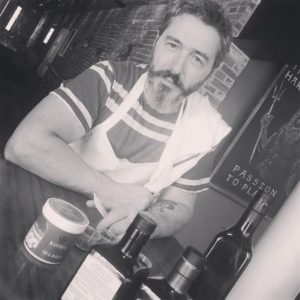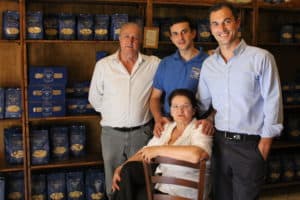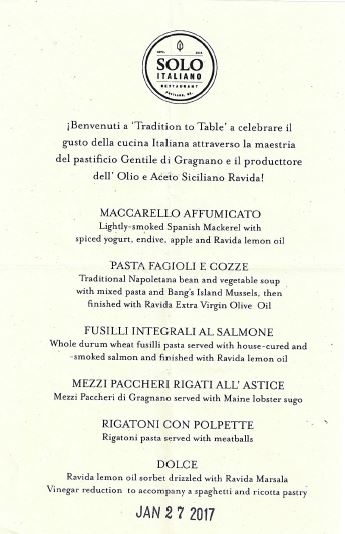A Dinner with Pasta Gentile at Solo Italiano with Chef Paolo Laboa
In a time of big, global business, it sometimes seems that human connections get swallowed up by massive-scale commerce. What happened to people knowing your name? Can family businesses still thrive in this competitive market where speed and low-cost reign supreme over integrity and quality? The short answer is, YES!
Rogers Collection is humbled and honored to be in connection with many such companies.
Recently, an exquisite example of this merging of family businesses happened right here in the home of RC—Portland, Maine. And I have to say, it was beautiful to behold. This Maine blog writer—that’s me—was wicked (that’s Maine-speak for “very”) excited!
In late January, I navigated the icy sidewalks of Portland to attend a Tradition to Table dinner hosted by RC at Solo Italiano that illustrates this integration of minds, hearts and souls during one glorious dinner. If the love of good food is not a tie that binds us, I don’t know what is!

For this event, we teamed up with Pastificio Gentile to have a four-course pasta dinner prepared by Solo Italiano’s Chef Paolo Laboa. Gentile’s owner Alberto Zampino was in-house at Solo Italiano dining and chatting with guests as Paolo popped in and out of the kitchen. Zampino was fresh off of an exhilarating and exhausting Fancy Food Show in San Francisco. Portland was his last stop before hopping a flight back across the Atlantic. He was travel weary—dare I say, even a bit tattered— but his passion shone through. Paolo and Alberto—who had never met—hugged like brothers and spoke in rapid Italian. There were tears in their eyes as they bonded over their homeland and the love of food.
Now throw in a bunch of Mainers who braved frigid winter weather to partake in a meal that warmed the soul.

If this doesn’t show that collaboration among family businesses is alive and well—and well-appreciated—I don’t know what will.
Okay, now for a little back history. (If you’ve read my RC blog posts, you know I love my history!) You also know I keep it brief and don’t pass out quizzes afterwards.
Laboa grew up in Genoa, Italy where he was drawn to cooking with his mother and grandmother. He credits them both with the recipe that won him the Pesto World Championship in 2008. At the age of 13, he began what would be a life-long career in the kitchen, taking him from Genoa and Milan, to San Francisco and Napa, and then to Massachusetts to be closer to his wife’s family. And now here to Portland, Maine. This small seaside city feels very much like his beloved home of Genoa. Of Portland, he says, “I love having the sea in front and the mountains and forest in the back, so many different food flavors to work with.”
Moving on now to Pastificio Gentile di Gragnano!
Founded in 1876, it is one of the historic artisan factories (pastificio means “pasta factory”) that put Gragnano on the map as a city famous throughout the world for its pasta. It is run to this day by the Zampino family with Alberto heading up sales and business relationships and his brother, Pasquale, and father, Natale, seeing to production management, and his mother, Maria, in charge of their preserves product line San Nicola dei Miri.
Okay, there is so much cool stuff to say here, but I don’t want to lose the focus of the amazing dinner put on! I have mouth-watering pasta courses to describe.

So I’ll give you the highlights of what makes Gentile so incredibly special: the history of Gragnano, the process, the wheat. All I will say about the history is this: Gragnano is a city specifically designed in the 16th century to facilitate pasta production. In particular, architects designed buildings to allow in sunlight and invite in breezes from the Gulf of Naples to dry the pasta hanging outside. I mean, a city built keeping in mind how the breeze will flow through the buildings and dry the pasta?! That is serious stuff. But as time marched on, drying pasta in the streets was no longer feasible. So along came an in-factory drying technique—known as Metodo Cirillo, or the Cirillo Method named after the engineer who designed the technique. This process preserves that distinct aroma and consistency. Then bronze molds are used—rather than the common Teflon— to cut Gentile’s pastas which gives a porous surface for optimal sauce clinging! Cling is good.
Many things about the Gentile family business bring Alberto great pride. He says, “The close connection to the territory, the use of 100% Italian semolina, my entire family working on the project, [and] the renovation of an ancient mill in Gragnano’s Mills Valley to have our new production venue.”
Yup, put all those elements together and I would say you have a high-quality, family-produced and history-rich pasta.
So you have these amazing pastas paired with extraordinary olive oils, vinegars and sea salt and put in the hands of Chef Paolo—the results kind of blew my mind.
 Now for the food! The first pasta course was fagioli e cozze—a traditional Napoletana bean and vegetable soup. It had a mix of pastas, local Bangs Island Maine mussels with a finish of extra virgin olive oil. The dish was bursting with flavors and it was hearty, but not heavy. One of Chef Paolo’s trademarks is letting the flavors of the food shine through without being heavily masked.
Now for the food! The first pasta course was fagioli e cozze—a traditional Napoletana bean and vegetable soup. It had a mix of pastas, local Bangs Island Maine mussels with a finish of extra virgin olive oil. The dish was bursting with flavors and it was hearty, but not heavy. One of Chef Paolo’s trademarks is letting the flavors of the food shine through without being heavily masked.
Next was Fusilli Integrali Al Salmone with whole durum wheat fusilli pasta, house-cured and smoked salmon and lemon oil. Again, so flavorful and light!
Now we geared up for Mezzi Paccheri Rigati All’ Astice. This dish comprised Mezzi Paccheri di Gragnano with Maine lobster sugo. Literally, one dish held prized components from various regions from Italy to Maine. It was like community on a plate.
Finally, there was Rigatoni con Polpette—rigatoni pasta with
meatballs. So robust and savory and delicious! A classic, but it certainly had Chef Paolo’s touch.
Oh, and also, there was dessert. And it was made from pasta of course! Lemon oil sorbet was served with a spaghetti and ricotta pastry and finished with a drizzle of vinegar reduction. Again, light but singing with multiple flavors.
I’d be remiss if I didn’t mention the non-pasta starter which was the Maccarello Affumicato—the lightly smoked Spanish mackerel—served with spiced yogurt, endive, apple and lemon oil.
It’s one thing to read about food. It’s another to taste it.
Pastificio Gentile was symmetry in action in the hands of Chef Paolo. The quality of the products and the preparation as well as the community and the passion were in every single bite.
So, can you taste, feel, and see the difference in food that has history and love behind it? Do family businesses backed by integrity and passion stack up against the giants? Can people come together from all corners of the globe to unite their products and skills to create truly beautiful results? Yes, yes and YES!
A room full of folks in this small corner of the earth—including myself—were certainly eating up the results!
As Alberto Zampino stood mid-bite to graciously say goodnight—how many hand-shakes, talks and smiles had he exchanged
during the Fancy Food Show?—I could see through the exhaustion to the intrinsic drive that made his family’s pastas so special. Some things you can’t learn in a business book; some things are in your bones and in your heart—and it shows.
Written by Leska Tomash